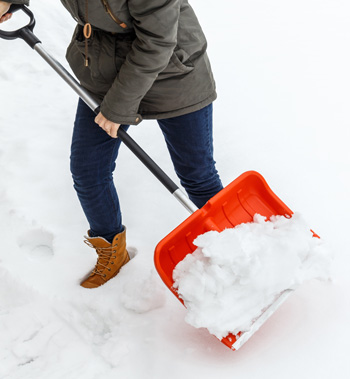With the advent of peak snow season, a local physical therapist is sharing practical snow shoveling tips that can prevent back injuries this winter. Americo Rodrigues, Partner at Integrated Rehabilitation Services, recently compiled these eight tips based on his 18 years of experience as a physical therapist.

1. Invest In the Right Equipment
If feasible, buy and use a snow blower. The bigger the area to snow blow, the more horsepower is needed. If you must use a shovel, buy a properly sized and ergonomically correct snow shovel. Most hardware stores have different sized shovels. If possible, purchase one that is angled, so that it prevents you from hunching over too much.
2. Before You Shovel, Dynamically Warm Up
Move side by side, perform trunk twists in rhythmic movements, bend forwards, and especially, bend backwards. You should perform 5-10 repetitions of each of these movements without holding the position (static stretching). Dynamic warm-ups will help you to avoid back issues when you shovel.
3. Lift With Your Legs More Than Anything Else
Keep your knees and hips bent. Push snow forward with your legs. Use your legs and arms in unison to lift the snow. Keep your back in a straight plane so that the back of your head and your buttocks are in a straight line, not hunched over. If you are unsure of this, place a broomstick on your back and hold one end on the back of your head with one hand and the other end of the broomstick on your buttocks with your other hand. You should be able to bend forward at your hips hinging at the hips while maintaining the two points of contact, the head and the buttocks. Your spine is therefore in a straight plane.
4. Keep the Load Light
People do not realize how heavy snow really is, until after they have injured their backs. Better to shovel many light loads of snow than fewer heavy loads. The heavier the snow, the lower your hand should be on the shovel, and the lower you should squat as you push and lift the snow.
5. The Lower Hand On Your Snow Shovel Is the Side You Throw the Snow
If your left hand is lower, then throw the snow to the left. If your right hand is lower, then throw the snow to the right. Every two minutes, switch hands. That will minimize the strain on one side or another.
6. Be Close to the Snow Pile & Don’t Let It Get Too High
Do not throw the snow far away. Remember, the higher the snow, the more weight you are lifting overhead, the more strain is exerted on your back.
7. Get Out and Shovel More Frequently and Stay Ahead of the Storm
The more you allow the snow to accumulate, the heavier the snow. This will increase the risk that you will injure yourself.
8. After You Shovel, Do Prone Progressions
Unless you have a known diagnosis that requires you to avoid or limit extension of the lumbar spine (ie, spinal stenosis or spondylolisthesis), when you come back inside, let your back relax. Lie prone (on your belly face down) and rest for 5-10 minutes. After this initial rest period, proceed onto your elbows and rest for an additional 5-10 minutes. If you do not feel any discomfort, you may want to perform press-ups which promote extension of the lower back. This will counteract all the lifting/shoveling you performed while outside. You may also perform standing back bends during your time outside shoveling and/or after you finish shoveling.
For more information, please call us at 860.870.8272.

